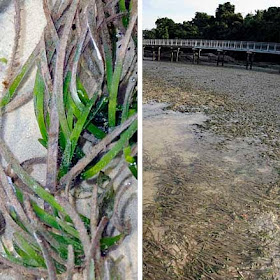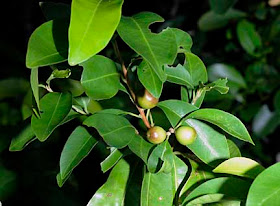 Yesterday, a few of us helped Siti with her seagrass work at Chek Jawa. We arrived late in the day for a narrow, not-so-low tide window. After Siti was done with her work, we had a quick look around to see how this shore is doing.
Yesterday, a few of us helped Siti with her seagrass work at Chek Jawa. We arrived late in the day for a narrow, not-so-low tide window. After Siti was done with her work, we had a quick look around to see how this shore is doing.It was an anemone day! I spotted the thick-bodied anemone that often settles on shells occupied by a hermit crab. We often see this on Changi. This is my first sighting for Chek Jawa! Also seen, the tiny sea anemone with a striped body that settles on the shells of living snails. This one settled on a Common whelk (Nassarius livescens) which was plentiful during our trip.
 What is this? It's some kind of anemone, but we're not sure. Perhaps a kind of Plain anemone? There's still so much more to learn about our shores!
What is this? It's some kind of anemone, but we're not sure. Perhaps a kind of Plain anemone? There's still so much more to learn about our shores! Near a larger Haddon's carpet anemone (Stichodactyla haddoni), Chay Hoon spots a pair of Kite butterflyfishes (Parachaetodon ocellatus). I have seen this behaviour before on Chek Jawa. There were many large Haddon's carpet anemones on the shore, though not as plentiful as before the mass deaths in 2007. I saw a few of them with early signs of bleaching, but most were alright. And one anemone had many tiny anemone shrimps.
Near a larger Haddon's carpet anemone (Stichodactyla haddoni), Chay Hoon spots a pair of Kite butterflyfishes (Parachaetodon ocellatus). I have seen this behaviour before on Chek Jawa. There were many large Haddon's carpet anemones on the shore, though not as plentiful as before the mass deaths in 2007. I saw a few of them with early signs of bleaching, but most were alright. And one anemone had many tiny anemone shrimps. There were several of these tiny carpet anemones, they are probably Stichodactyla tapetum. I notice brittle star arms sticking out near many of the carpet anemones big and small.
There were several of these tiny carpet anemones, they are probably Stichodactyla tapetum. I notice brittle star arms sticking out near many of the carpet anemones big and small. We came across several large brittle stars with flat arms. They are very fast moving! And quite colourful on the underside today. Perhaps they are full of eggs?
We came across several large brittle stars with flat arms. They are very fast moving! And quite colourful on the underside today. Perhaps they are full of eggs? We also saw lots of medium-sized Garlic Bread sea cucumbers (Holothuria scabra), I stopped counting after 20. But only a few Thorny sea cucumbers (Colochirus quadrangularis) and one Pink warty sea cucumber (Cercodemas anceps). We saw a few Plain sand stars (Astropecten sp), but alas, didn't come across any Common sea stars (Archaster typicus). These used to be abundant on Chek Jawa before the 2007 mass death. There were, however, lots and lots of Cake sand dollars (Arachnoides placenta) from the high shore to the low shore.
We also saw lots of medium-sized Garlic Bread sea cucumbers (Holothuria scabra), I stopped counting after 20. But only a few Thorny sea cucumbers (Colochirus quadrangularis) and one Pink warty sea cucumber (Cercodemas anceps). We saw a few Plain sand stars (Astropecten sp), but alas, didn't come across any Common sea stars (Archaster typicus). These used to be abundant on Chek Jawa before the 2007 mass death. There were, however, lots and lots of Cake sand dollars (Arachnoides placenta) from the high shore to the low shore.There were many Noble volutes (Cymbiola nobilis) of all sizes bulldozing busily in the sandy parts of the meadows. Mei Lin got a video clip of one burrowing out of the sand! Indeed, these large predatory snails hunt for buried prey. It must have just finished having an early dinner.
 Other snails that were seen include several Tiger moon snails (Natica tigrina) and a Black-lipped conch (Strombus urceus). There were lots and lots of Gong-gong (Strombus canarium).
Other snails that were seen include several Tiger moon snails (Natica tigrina) and a Black-lipped conch (Strombus urceus). There were lots and lots of Gong-gong (Strombus canarium). I came across a living Turrid snail (Turricula sp.). So far, I've only seen this snail at Chek Jawa, and another shore which has since been lost to development. So it's good to see it again at Chek Jawa.
I came across a living Turrid snail (Turricula sp.). So far, I've only seen this snail at Chek Jawa, and another shore which has since been lost to development. So it's good to see it again at Chek Jawa. The conical hat-shaped thing on the shell occupied by a hermit crab is a Slipper snail (Clyptraea extinctorium)! There were many Striped hermit crabs (Clibanarius sp.) and Tidal hermit crabs (Diogenes sp.) in the meadows.
The conical hat-shaped thing on the shell occupied by a hermit crab is a Slipper snail (Clyptraea extinctorium)! There were many Striped hermit crabs (Clibanarius sp.) and Tidal hermit crabs (Diogenes sp.) in the meadows. Chay Hoon also spots a pair of tiny Pygmy squid (Idiosepius sp.) and of course many tiny slugs and other very small creatures.
Chay Hoon also spots a pair of tiny Pygmy squid (Idiosepius sp.) and of course many tiny slugs and other very small creatures.Chay Hoon also found a mantis shrimp (Harpiosquilla sp.)! There were a lot of Flower crabs (Portunus pelagicus) too, from many tiny ones to a huge one that Siti saw. I also saw a little Leaf porter crab (Family Dorripidae).
 We came across a ball of tiny squirming eeltail catfishes (Plotosus sp.)! These fishes stay together for safety. From afar, they look like a big scary creature.
We came across a ball of tiny squirming eeltail catfishes (Plotosus sp.)! These fishes stay together for safety. From afar, they look like a big scary creature. Mei Lin shows me a tiny Tripodfish (Family Triacanthidae). It's hardly bigger than a blade of Spoon seagrass (Halophila ovalis). Today, much of the seagrasses nearer the shore was covered with a scummy growth. We don't know that it is.
Mei Lin shows me a tiny Tripodfish (Family Triacanthidae). It's hardly bigger than a blade of Spoon seagrass (Halophila ovalis). Today, much of the seagrasses nearer the shore was covered with a scummy growth. We don't know that it is. There are several patches of greenish Beccari's seagrass (Halophila beccarii) near the boardwalk! Alas, they too are covered with scum.
There are several patches of greenish Beccari's seagrass (Halophila beccarii) near the boardwalk! Alas, they too are covered with scum. Smooth ribbon seagrass (Cymodocea rotundata) is quite special as it's only found on a few of our shores. The patch at Chek Jawa has expanded tremendously! But the leaf blades are covered with scum. Unlike my trip a few weeks after the oil spill, I didn't see any bleaching seagrasses on this trip. The scum, though, is rather worrying.
Smooth ribbon seagrass (Cymodocea rotundata) is quite special as it's only found on a few of our shores. The patch at Chek Jawa has expanded tremendously! But the leaf blades are covered with scum. Unlike my trip a few weeks after the oil spill, I didn't see any bleaching seagrasses on this trip. The scum, though, is rather worrying. In some parts of the shore, the Fern seagrasses (Halophila spinulosa) are doing well. The green meadows are dotted with peacock anemones (Order Ceriantharia) of all colours.
In some parts of the shore, the Fern seagrasses (Halophila spinulosa) are doing well. The green meadows are dotted with peacock anemones (Order Ceriantharia) of all colours. My favourite, a lilac coloured peacock anemone!
My favourite, a lilac coloured peacock anemone! In the distance, the seagrass meadows are teeming with migratory shorebirds. Their melodious calls ring throughout our visit. As we approach the end of the year, the shorebirds are coming back to our part of the world to escape the northern winter. Shores such as Chek Jawa are important places for them to refuel for their long journey.
In the distance, the seagrass meadows are teeming with migratory shorebirds. Their melodious calls ring throughout our visit. As we approach the end of the year, the shorebirds are coming back to our part of the world to escape the northern winter. Shores such as Chek Jawa are important places for them to refuel for their long journey. Some of the birds are boldly patterned. Still in their summer breeding plumage?
Some of the birds are boldly patterned. Still in their summer breeding plumage? I had a quick look at the rare coastal plants there. The Nyatoh (Pouteria linggensis) seems to be doing alright and is fruiting! The Delek air (Memecylon edule) was not fruiting or flowering but seemed fine. Both plants are listed as Critically Endangered in our Red Data book.
I had a quick look at the rare coastal plants there. The Nyatoh (Pouteria linggensis) seems to be doing alright and is fruiting! The Delek air (Memecylon edule) was not fruiting or flowering but seemed fine. Both plants are listed as Critically Endangered in our Red Data book. Compared to the oil-hit shores at Tanah Merah that I have been visiting regularly, things seem more or less normal on Chek Jawa. In fact, marine life on Chek Jawa was more badly affected by the 2007 mass deaths and to me, it still hasn't recovered fully from that event.
Compared to the oil-hit shores at Tanah Merah that I have been visiting regularly, things seem more or less normal on Chek Jawa. In fact, marine life on Chek Jawa was more badly affected by the 2007 mass deaths and to me, it still hasn't recovered fully from that event.Well, TeamSeagrass will be back on Chek Jawa for our regular monitoring in October, and we shall continue to see how the shore is doing.
Hopefully, more study and work can be done on Chek Jawa. To better understand, and protect this unique and precious shore.
Other posts about this trip
- Mei Lin with a video clip of a Noble volute emerging from under the sand!
